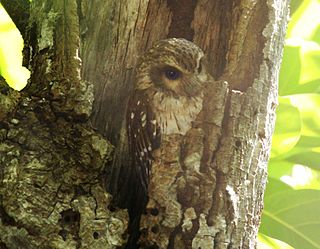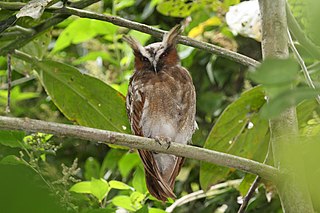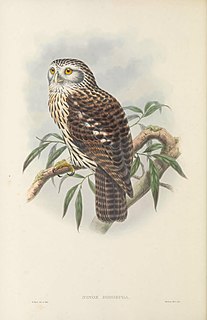 W
WThe true owls or typical owls are one of the two generally accepted families of owls, the other being the barn owls (Tytonidae). The Sibley-Ahlquist taxonomy unites the Caprimulgiformes with the owl order; here, the typical owls are a subfamily Striginae. This is unsupported by more recent research, but the relationships of the owls in general are still unresolved. This large family comprises nearly 220 living species in 25 genera. The typical owls have a cosmopolitan distribution and are found on every continent except Antarctica. There are three accepted subfamilies of Strigidae including Striginae, Asioninae, and Surniinae.
 W
WAsphaltoglaux cecileae is an extinct species of true owl which existed in what is now California, U.S.A. during the Late Pleistocene age. The species is known from the La Brea Tar Pits. Its osteology suggests a close relation to the owls of the genus Aegolius.
 W
WThe bare-legged owl, also called the Cuban bare-legged owl or Cuban screech owl, is a species of owl in the family Strigidae that is endemic to Cuba and Isla de la Juventud. It belongs to the monotypic genus Margarobyas.
 W
WThe crested owl is a species of owl in the family Strigidae. It is the only species (monotypic) in the genus Lophostrix. It is a resident bird and occurs in Central America and northern South America. It is a medium-sized owl, easily recognizable with its very long whitish ear tufts and otherwise darker appearance. It inhabits lowland rainforests and prefers old growth in proximity with water. The crested owl is a strictly nocturnal species, but very little is known about its behaviour.
 W
WFishing owls are a group of sub-Saharan African birds in the family Strigidae, the true owls. Fishing owls have traditionally been placed in the genus Scotopelia, but DNA evidence suggests they should be included in genus Bubo with the horned owls and eagle-owls.
 W
WThe flammulated owl is a small, nocturnal owl approximately 15 cm (6 in) long with a 36 cm (14 in) wingspan. With such large wings for a small body, they can fly rapidly from tree to tree. Males and females can be distinguished by their weight. Females are larger, ranging from 62–65 g (2.2–2.3 oz) and males are smaller ranging from 50–52 g (1.8–1.8 oz). The owl gets the name flammulated from the flame-like markings on its face. It breeds from southern British Columbia and the western United States to central Mexico. It is a neotropical migrant and winters south of the United States, but also in South Texas, Arizona, and California. Unlike many owls, they are migratory, leaving Canada and the United States in the fall. In the winter, they are found in northern Central America, from southern Mexico to Guatemala and El Salvador. They leave their breeding grounds in August to head to their wintering areas, and then return to their breeding grounds in late April and early May. The flammulated owl is similar in appearance to the western screech owl, but is only about one-quarter the mass, lacks large ear tufts, and has dark eyes and a different voice. The elf owl is smaller and the mountain pygmy owl is about the same size. The call is a series of relatively deep, single or double hoots.
 W
WThe laughing owl, also known as whēkau or the white-faced owl, was an endemic owl of New Zealand. Plentiful when European settlers arrived in New Zealand, its scientific description was published in 1845, but it was largely or completely extinct by 1914. The species was traditionally considered to belong to the monotypic genus Sceloglaux Kaup, 1848, although recent genetic studies indicate that it belongs with the boobook owls in the genus Ninox.
 W
WThe maned owl or the Akun scops owl, is a species of owl in the family Strigidae that is endemic to Africa. It is the only species in genus Jubula.
 W
WThe Mascarene owls, also known as Mascarene scops owls or lizard owls, were those belonging to the genus Mascarenotus. They were restricted to the Mascarene Islands in the Indian Ocean. All three species, the Réunion owl, Mauritius owl, and Rodrigues owl, are now extinct.
 W
WOraristix brea, the Brea owl, is an extinct owl reported from the upper Pleistocene asphalt deposits of the La Brea Tar Pits in Los Angeles, California. It was first described in 1933 by Hildegarde Howard as Strix brea, but this extinct owl was recently placed into its own genus by Campbell and Bocheński (2010). The Brea owl has also been found in the upper Pleistocene asphalt deposits of Carpinteria, California. Oraristrix brea is interpreted as more terrestrial in habits than forest owls because, compared to North American species of Bubo and Strix, it had longer legs relative to its wingspan.
 W
WThe Cuban giant owl or giant cursorial owl (Ornimegalonyx) is an extinct genus of giant owl that measured 1.1 metres in height. It is closely related to the many species of living owls of the genus Strix. It was a flightless or nearly flightless bird and it is believed to be the largest owl that ever existed. It lived on the island of Cuba.
 W
WThe Papuan hawk-owl is a medium-sized, sleek owl with a proportionately small head, long tail, and short, rounded wings. Its white facial disk is small and indistinct, with black streaks, and white eyebrows. It has buff-colored upperparts and barred black and brown underparts. Its eyes are bright yellow, and it has a gray to black bill. The male is larger than the female, which is unusual among owls.
 W
WThe Puerto Rican owl or múcaro is a nocturnal endemic owl of the archipelago of Puerto Rico belonging to the genus Gymnasio of the family Strigidae. The subspecies, G. n. newtoni, which was endemic to the Virgin Islands, was locally referred to as the cuckoo bird.